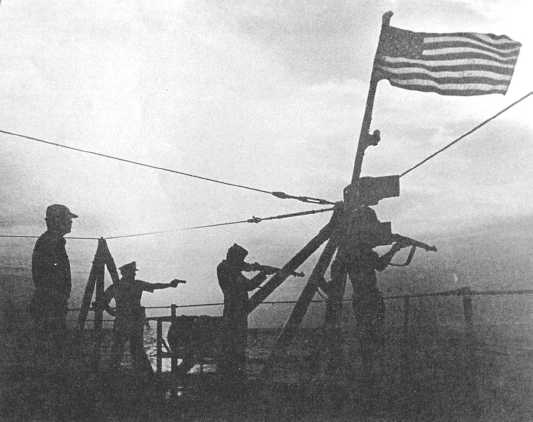Figure 5-17.–Low-key scene.
PH2 Neil Crews
302.301
LOW- AND HIGH-KEY SCENES.–When a
scene contains mostly dark tones or colors, it is low key
(fig. 5-17). When the scene contains mostly light tones,
it is high key (5-18). Low-key and high-key pictures
convey mood and atmosphere. Low key often suggests
seriousness and mystery and is often used in horror
pictures, such as a dark-granite castle in a thunderstorm.
High key creates a feeling of delicacy and lightness. A
photograph of a fair-skinned, blond-haired mother
dressed in a white gown against a light background
nursing her baby is a good subject for a high-key picture.
HIGH- AND LOW-KEY COLORS.–High-key
color pictures contain large areas of light desaturated
colors (pastels) with very few middle colors or shadows.
Intentionally overexposing color film (exposing for the
shadows) helps to create a high-key effect.
A low-key effect is created when the scene is
dominated by shadows and weak lighting. Low-key
pictures tend to have large areas of shadow, few
highlights, and degraded colors. Naturally dark subjects
are best for low-key pictures. Low-key color pictures
can be induced by exposing color film for the highlights.
FRAMING
Framing is another technique photographers use to
direct the viewer's attention to the primary subject of a
picture. Positioned around the subject, a tree, an
archway, or even people, for example, can create a frame
within the picture area. Subjects enclosed by a frame
become separated from the rest of the picture and are
emphasized. Looking across a broad expanse of land or
water at some object can make a rather dull uninteresting
view. Moving back a few feet and framing the object
between trees improves the composition.
An element used as a frame should not draw
attention to itself. Ideally, the frame should relate to the
theme of the picture; for example, a line of aircraft
parked on the flight line framed by the wing and prop of
another aircraft.
Not only is framing an effective means of directing
the viewer's attention, it can also be used to obscure
undesirable foregrounds and backgrounds. The illusion
of depth can be created in a picture by the effective use
of framing (fig. 5-19).
5-20


